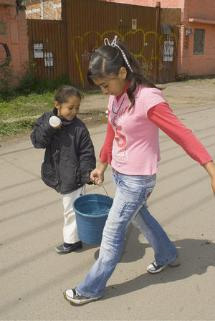
|  |  |  News Around the Republic of Mexico | September 2009 News Around the Republic of Mexico | September 2009  
Drought, Growth, Poor Planning Take Toll on Mexico City
 Dudley Althaus - Houston Chronicle Dudley Althaus - Houston Chronicle
go to original
September 01, 2009


| | Because of mandatory water rationing, residents of Mexico City's San Nicolas area are forced to haul buckets of water collected from a neighbor's hose. (Keith Dannemiller/Express-News) |  |
Mexico City — As in much of Texas, drought has clobbered great swaths of Mexico this year, killing crops and livestock and threatening to dehydrate major cities.

Among the hardest hit are Mexico City and its sprawling suburbs, home to some 22 million people.

Taps already are running dry for weeks at a time in large sections of the metropolitan area, especially in poorer neighborhoods. Officials warn that without extraordinary deluges in coming weeks, extreme scarcity will stalk the area once the dry season begins in late October.

“We are on a collision course,” said Lorenzo Rosenzweig, director of a Mexico City foundation that finances water studies and other environmental programs. “The whole way we manage this watershed has to be rethought.”

The mountain-encircled basin that holds the Mexican capital was a vast lake bed when the Spaniards took it from the Aztecs nearly 500 years ago. Planners have been draining it ever since to make way for humans, treating the area's water more as a nuisance than a necessity.

That worked well for a long time. It doesn't any more.

“We've reached the end of a model,” said Arkansas-born Elena Burns, a naturalized Mexican citizen who helped coordinate a recent proposal to re-engineer Mexico City's watershed. “It's not sustainable.”

Decades of explosive population growth and poor planning have badly stressed the aquifers that supply three-quarters of the area's water. Three times as much water is sucked from the basin's aquifers as trickles back into them.

Tunnels today flush most rainfall and sewage runoff to the lowlands northeast of the city and on to the Gulf of Mexico, depriving the groundwater of replenishment. The water flowing daily out of the basin nearly equals the amount pumped into it from aquifers and the distant Cutzamala and Lerma reservoir systems, Burns said.

“Poorer people have been living with scarcity for years,” she said. “Now this reality is becoming generalized.”

In one indication of the stress, Burns says, “fossil water” that's 2,000 years old is being pumped up from an aquifer beneath one parched section of Mexico City this summer.

“The problem in the Valley of Mexico is the overexploitation of the aquifers,” said Jose Luis Luege, director of the National Water Commission. “That is problem No. 1.”

Drought might seem a strange notion in the Mexican capital; it has rained almost every night — and many days — since the wet season began in earnest three months ago. But few of the showers have been the sort of hailstorming, street-flooding, mudslide-making gully washers that Mexico City residents expect and the basin's fragile hydrology needs.

Cutzamala and other systems that supply the Mexico City basin now hold but a fraction of their normal volume. To assure a supply of water during the coming dry season, local officials this month ordered a 30 percent cut in the supply from those reservoirs to the city.

“This is a high-risk situation that can literally leave us without water,” Mexico City Mayor Marcelo Ebrard warned this month. “We can find ourselves in a situation in which our reservoirs are empty.”

Largely dependent on the Cutzamala supply, hundreds of thousands of people in Mexico City's southern reaches already have been going without water much of this year.

“The officials control the valves and decide which neighborhoods get water,” said architect Roberto Fernandez, 41, one of a dozen people filling buckets from the still-functioning hose of a neighbor lucky enough to be connected to a groundwater supply.

“People live with the uncertainty from week to week,” Fernandez said. “Next year is going to be really criminal.”

But Fernandez's community — San Nicolas — explains the roots of the crisis as well as its impact. A gray sprawl of densely packed working-class houses, it was thrown up haphazardly on what 15 years ago was pastureland and cornfields.

Concrete and asphalt covered porous soil. Rain that seeped into the aquifer now gushes into storm drains and out of the city. The creeks that long tumbled from the mountains have shrunk to trash-filled and weed-choked gurgles.

Tens of thousands of new residents have replaced the several hundred who originally lived in San Nicolas. Many more thousands of toilets are flushed, showers taken, dishes washed and drinks drunk.

“There are just too many of us in this city,” said diner owner Rafaela Camacho, a San Nicolas native whose family farmed the hillsides for generations. “The Earth can't handle so many of us.” |

 |
|  |



